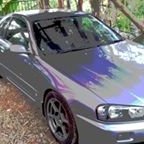Announcements
-
Similar Content
-
Latest Posts
-
Thank you for explaining. Makes more sense now. I saw that diagram but wasnt sure if the MAC solenoid would use the same plumbing. So I just did what the stock looked like. Ill get that fixed. As for MAP sensor, When I place vacuum line from MAP to stock location vac reference ( port by BOV flange ) the car runs like crap. I think the port is clogged or something, cause when I moved the MAP line to plenum and connected the BOV to that line, I get compressor surge. This is why I moved MAP vacuum line to plenum where BOV is. Where can I T the MAP vacuum? Sources Ive read said to let MAP vacuum be its own and not to T.
-
You've done it wrong. I don't have time right now to type up enough. I'll have to come back to it or maybe someone else will in the meantime. The boost signal has to pass through the MAC valve from boost source (turbo outlet - effectively anywhere between the turbo outlet and the throttle body will do, but closer to the turbo outlet is best) to the wastegate. What you have done is connected it sort of like the stock solenoid. But it doesn't work the same way as the stock solenoid. That Tee piece that you have connected the solenoid to....? The solenoid itself serves that function. You should look up a typical MAC valve connection diagram for a single turbo internal wastegate application. You'll find one easily enough. Every single boost controller manufacturer that uses MAC valves will have one. Bugger it, I'll just grab the HP Academy one. The other thing you have to get right is that the boost source has to be connected to the correct port on the solenoid valve. This is because the solenoid makes the valve switch from connecting 2 of the ports when it is unpowered, to connecting one of those first 2 ports to the third port when it is powered. One inlet, two outlets. You will note from the diagram that the common port is port 3, the port to the wastegate is port 2, and port 1 is the vent (where the boost signal escapes when the solenoid pulses ON). As to the BOV.... the vacuum signal for the BOV simply has to come from the plenum. It must register boost when you're on boost and vacuum when the throttle is closed. That's all. The original location on the plenum is best. Best practice is never to interfere with the vacuum line running to the FPR. Just leave that one alone, as you will avoid causing unintended problems that might occur if you mess something up.
-
I was able to complete installation of the G4X ecu. I needed to reroute MAP vacuum signal from stock location to where BOV is connected on the intake plenum. Has anyone needed to do the same? When I connect vac port by the BOV flange to my HKS BOV, it doesnt work and I get flutter. I would to get BOV working, where would it be best to T in? Or would it best for me to move MAP vac line and T into FPR? Secondly, I installed a MAC 3 port boost solenoid and wanted to know if i routed it correctly. I place two lines from stock boost solenoid and placed it on ports 1 and 2, leaving 3 vented. The T for wastegate and boost source on compressor elbow is on port 2, and port 1 is connected to turbo inlet intake pipe. Please see attached pictures. Ill upload ecu config later today. Thanks in advance.
-
some people are still around weirdly enough - most people just use facebook now to ask the same 12 questions tho XD
-
Omg Rezz! Yep we're still here and actually seeing a trickle of oldies coming back. How's things?
-






Recommended Posts
Create an account or sign in to comment
You need to be a member in order to leave a comment
Create an account
Sign up for a new account in our community. It's easy!
Register a new accountSign in
Already have an account? Sign in here.
Sign In Now